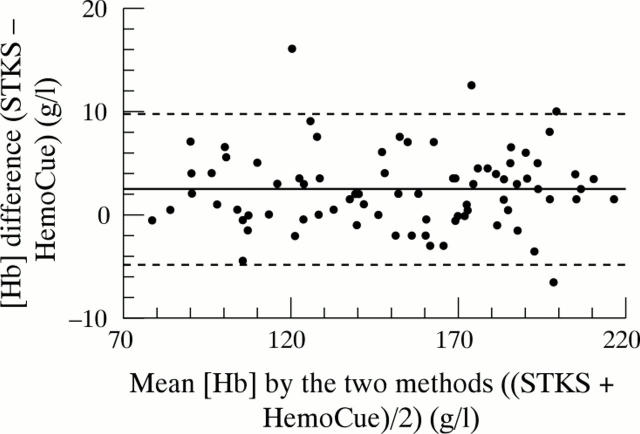Abstract
Objective: To compare the measurement of haemoglobin concentration ([Hb]) using the HemoCue haemoglobinometer with that using the Coulter STKS haemoglobinometer.
Design: Thirty two EDTA samples were taken from neonates. [Hb] was measured in these samples using the HemoCue; the samples were then transferred to the haematology laboratory for [Hb] determination with the Coulter STKS. In addition, [Hb] was determined in 50 different random EDTA neonatal samples already held in the laboratory, using the HemoCue and Coulter STKS.
Patients: Neonates in the intensive care and low dependency Units of the Royal Devon and Exeter Hospital.
Interventions: Samples were collected from arterial lines or by venepuncture or heel prick into an EDTA bottle.
Main outcome measures: [Hb] using the HemoCue and Coulter STKS methods.
Results: The mean [Hb] measured using the HemoCue was 150.3 g/l (range 78–215) compared with 152.8 g/l (range 78–217) measured using the Coulter STKS, with a mean of the differences of 2.5 g/l. The standard deviation of the differences of the 82 samples was 3.73 g/l. The limits of agreement of the two methods (mean difference ± 2SD) were -4.8 to +9.8 g/l.
Conclusion: With adequate training and monitoring, the HemoCue can be used directly on the neonatal unit for rapid determination of [Hb] to within 7.5 g/l compared with the laboratory Coulter STKS, using much smaller sample volumes.
Full Text
The Full Text of this article is available as a PDF (76.3 KB).
Figure 1 .
Plot of the difference between the results obtained by the two methods against the mean of the results obtained by the two methods of haemoglobin measurement (n = 82). The dashed lines indicate the limits of agreement. [Hb], Haemoglobin concentration.
Selected References
These references are in PubMed. This may not be the complete list of references from this article.
- Berry S. M., Dombrowski M. P., Blessed W. B., Bichalski J. A., Jones T. B., Cotton D. B. Fetal hemoglobin quantitations using the Hemocue system are rapid and accurate. Obstet Gynecol. 1993 Mar;81(3):417–420. [PubMed] [Google Scholar]
- Cohen A. R., Seidl-Friedman J. HemoCue system for hemoglobin measurement. Evaluation in anemic and nonanemic children. Am J Clin Pathol. 1988 Sep;90(3):302–305. doi: 10.1093/ajcp/90.3.302. [DOI] [PubMed] [Google Scholar]
- Laifer S. A., Kuller J. A., Hill L. M. Rapid assessment of fetal hemoglobin concentration with the HemoCue system. Obstet Gynecol. 1990 Oct;76(4):723–724. [PubMed] [Google Scholar]
- Strauss R. G. Transfusion therapy in neonates. Am J Dis Child. 1991 Aug;145(8):904–911. doi: 10.1001/archpedi.1991.02160080082025. [DOI] [PubMed] [Google Scholar]
- Vanzetti G. An azide-methemoglobin method for hemoglobin determination in blood. J Lab Clin Med. 1966 Jan;67(1):116–126. [PubMed] [Google Scholar]



